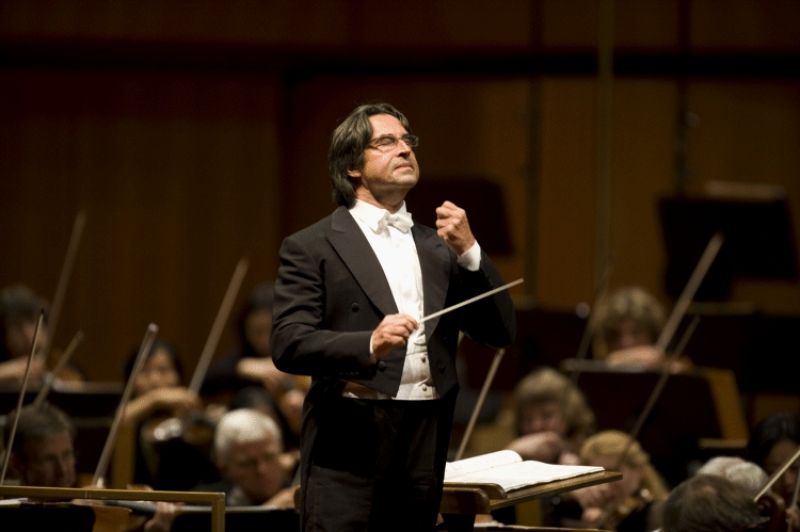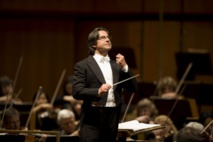Before the 19th century, the pace of music was controlled by someone hitting the stage with a stick. Then, the chronometer was invented and the orchestra had a conductor who controlled the pace. Now we see over 100 players in the Chicago Symphony Orchestra conducted by the remarkable Italian maestro Riccardo Muti inaugurating the musical season in San Diego in one of
the most exquisite galas playing the beautiful music of Schubert, Mozart, and Schumann.
Thanks to La Jolla Music Society with its head Kristine Lancino that we can enjoy some of the best musical talents in the world who entertain this gorgeous city overlooking the Pacific Ocean. She has been an expert in planning and programming ever since she worked at the Carnegie Hall in New York.
Muti is considered one of the top living conductors on the globe. He had worked for 19 years in the illustrious Opera La Scala in Milano, Italy, where he became one of the most prominent and intelligent musical personalities, in the world. He will conduct the annual New Year concert in Vienna at the end of this year. Millions all around the world will watch this unique event on their TV screens.
Muti’s San Diego concert started with the Unfinished Symphony (No. 8) by the Austrian composer Franz Schubert . From the first instance, we found ourselves in front of a masterful orchestra. Formed in 1891, the Chicago Symphony Orchestra had own sound even before it was led by Fritz Reiner or later by Sir Georg Solti. When in 1902 the famous German composer Richard Strauss conducted it for his piece “ Thus Spoke Zarthustra” he immediately realized the orchestra’s its high quality and did not require more than one rehearsal. In San Diego , the complete harmony between the orchestra and Riccardo Muti was visibly noticed. Muti succeeded in giving prominence to the strings by not allowing the brass instruments to overshadow the sound as many American orchestras do. It seems that he followed the advice of Richard Strauss who said that the conductor should not encourage the loud brass, but one quick look towards them is sufficient at the important passages.
Muti’s interpretation of Schubert showed him as an ordinary talented man, quite humble, and full of natural unpretentious emotions sharing humanity in its feelings and excitement. Schubert, who died in 1828 at 31 years of age composed this symphony when he was 25 years old and he never heard it performed during his lifetime. He left us only two movements of the usual four because he may have felt that his message was sufficient as a personal expression with the main musical theme that sounds like his 600 beautiful melodic songs (called lieder in German). What distinguishes the Unfinished Symphony is that it makes the musical instruments “ sing” in a romantic emotional manner.
Muti did not rush the pace but controlled it perfectly. He let the waves take their course and embody the harmony between the themes and musical lines. Sometimes critics accuse him of being somewhat stern, but in truth he gives every sentence its due as the composer wished. In that respect he follows the style of the great conductor Arturo Toscanini whom he admires. Muti sets his standard as high, and his criteria are precision and brevity. He says “ it is a unique moment when the conductor feels that he, his orchestra and audience are on the same pulse and heart beat “. I’m not aware if Muti recorded this particular symphony by Schubert, but we can find an excellent CD recording by Claudio Abbado who preceded Muti in his position in Opera La Scala di Milano.
The concert also included the clarinet concerto by Mozart. The good performance was punctuated sometimes by a bit of hesitation by the clarinet player but the piece was overwhelmingly pleasing. The real masterpiece came at the end with Robert Schumann’s second symphony which was composed after he and his able pianist wife Clara visited Russia in 1844. Although Schumann had suffered from depression and sadness, we do not notice any trace of his psychological situation in this marvellous work.On the contrary, the music gives the impression of happiness, the shinning sun and force. Perhaps the tunes were the best remedy for Schumann because he rediscovered himself and reinforced his brilliance. He was the perfectionist introvert type who hides his thoughts and feelings but he was able to be one of the leaders of the romantic movement in Germany. He started his artistic life in a non traditional way. He considered that the idea and content impose themselves over the form of composition or writing since they are no rules engraved in stone about creativity. This obviously modern concept was a pioneering idea in the 19th century, an era fond of strict rules. But Schumann returned to Classicism in his four symphonies. While his melodies expressed what he was thinking he felt a short phrase could summarise his thought instead of a lengthy repellent expression.
Muti proved his ability and strong personality and the depth of his knowledge by interpreting the second symphony in a realistic balanced way that describe the composer’s inner feelings with strong emotions and refined human perception and sensation. One of the best recordings of this piece can be found in an old recording by the Chicago Symphony Orchestra led by its former conductor Fritz Reiner.
Muti’s background and long experience can be traced to his birth in Napoli in Italy in 1941. His father was a medical doctor who appreciated Riccardo’s artistic talent but he insisted that he should get his high school degree in literature and philosophy and then enter the music conservatory in Napoli. His musical teacher was a student of the well known pianist Alfred Cortot. Later Muti moved to the conservatory in Milano and was tutored by famous maestro Antonio Votto known for his unmatched recordings of Italian operas with the soprano Maria Callas. After graduation Muti led the renowned “Maggio Musicale” festival in Florence. He then he participated in the Salzburg musical festival and presented, for the first time in 1972, the full opera of Rossini about the hero William Tell. He took over the post of conductor of the Philharmonia Orchestra in London as a successor to Otto Klemperer, and then added another feather to his record as the conductor of the Philadelphia Orchestra in the USA in addition to his duties in Opera La Scala in Milano. He has been a continuous guest conductor to the Philharmonic orchestras in Berlin, Vienna, and New York as well as being nominated as conductor for life to the Opera House in Rome.
It was remembered that when he conducted the Verdi’s opera Nabucco in Rome in 2010 he stopped playing when the chorus started singing the famous “ va pensiero” ( my country on my mind) and turned to the audience saying : that the Belusconi government wants to achieve austerity by reducing subsidies to art and culture but they forgot that culture is the glew that ties people with each other . He then resumed the choral song and the crowd sang it loudly with the chorus. When President Napolitano heard what happened he rushed to attend the opera performance the day after stressing his support and the need to abolish the austerity measures that affect the cultural life in Italy.
Muti carefully follows world political events, and he was the first to have a concert in Bosnia during the Yugoslav civil war. He had another concert in Bosra in Syria before the current troubles started with the participation of Syrian and Italian musicians in the orchestra.His message was always that of peace and friendship. He told me after the concert in San Diego that he had recently returned from a visit to Teheran after the new formation of the old symphony orchestra under the conductor Shirdad Rouhani that was originally established by the Shah of Iran some 45 years ago. The revolution in that country put a ban on Western and even Oriental music during the rule of the Khomeini regime. Muti was pleased to have a joint performance between the Cherubini Youth Orchestra from Italy and the revitalised Teheran symphony orchestra. He added that he told them that Verdi’s music is for everybody in the world and not only for Western audiences, because Verdi was a nationalistic artist who believed in patriotism, fraternity and freedom. Thus, Muti uses music as a mean for closer ties and dialogue between civilisations.
He is truly an extraordinary conductor of the type that the great German composer Richard Wagner would classify as a virtuoso , which is an exceptional artist with masterly finesse and graceful personality of the Italian nice type.









 Home
Home Politics
Politics











